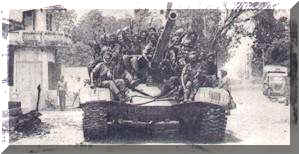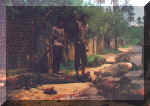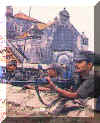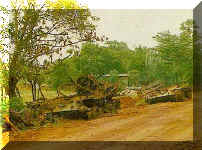The Sri Lankan Interlude
Operation Pawan
- Details
- Created: 12 October 2006
- Written by Super User
- Hits: 26140
Operation Pawan - The Battle for JaffnaThe rules of engagement for this operation were strict and once again tied the Indian Army's hands. Use of artillery, heavy weaponry and offensive air support was forbidden to minimise civilian casualty and damage to property. The Indian Army's plan was to cripple the LTTE guerrilla network by capturing its headquarters in Jaffna City, a task the Sri Lankan Army had tried this for many years but had not succeeded. Pushed by the political/bureaucratic establishment the Army made a hasty plan. However it had only 91st Brigade under Brigadier J. Ralli consisting of only three battalions. One was at the front, one at point Pedro and one west of Palaly. Furthermore each battalion was staffed to only 50% and had none of its heavy weapons as they had not been expecting a fight. The IPKF push into the city was contested by the LTTE at every nook and corner. It had to fight against heavily armed guerrilla, in a heavily built up and densely populated urban area already fortified and extensively mined during the three years of war with the Sri Lankan Army. Both sides took heavy casualties. Furthermore all the approach roads were pitted with Claymore mines or huge drums filled with explosives, buried in the ground. The whole area was flooded with IEDs (Improvised Explosive Devices) which could be detonated by remote or radio control from over a kilometre away.  Troops of 13 Sikh LI traverse the roads of Jaffna on a T-72 tank of the 65 Armoured Regiment at the height of the fighting.One such explosion killed 29 IPKF personnel. The attack took place along five axis to the city. A bold plan to make a heli borne assault on Jaffna University to capture the LTTE leadership was made. The plan involved a company of 10 Para Cdos. to act as path finders. They were to be followed by a company of Sikh LI. If all went to plan the heli borne troops would be linked with troops coming by land. On the night of 11/12th October 1987, the plan was put to effect. But unknown to the Indian troops, was the fact that the LTTE had sophisticated Japanese radio sets which were monitoring IPKF communications. Heavy and sustained machine gun fire pinned down the commandos killing six of them instantly. The Mi-8s were damaged but made it back to base. A further flight of helicopters brought in a platoon from the Sikh LI. These came under even more intense fire. As the men from the Sikh LI ran out of ammo, they made a valiant bayonet charge. All but one perished. The commandos had conserved their ammo but were close to running out. Still they managed to hold out the entire night. Next morning their battalion commander, Lt. Col. Dalbir Singh personally led a column of T 72 tanks to relieve them.  Troops waiting to board a Mi-8 of No.109 HU equipped with rocket pods for an assault mission.At this point the major operational base for the IPKF was Palaly airbase. This was a hub of LTTE activity and therefore a constant battle to secure it from guerrilla attacks. The IPKF was badly overstretched. On October 15/16 it halted its advance to stabilize its front. A massive airlift was undertaken to reinforce it with 3 brigades and heavy equipment. These included T-72s and BMP-1s. The improvised controllers worked round the clock to fly in troops and equipment. While the IL-76s and An-12s moved the heavy equipment the AN-32s, Hs.748s and Indian Airlines B737s brought in the troops. So heavy was the traffic that the runway in Tamabaram (Madras) cracked with the repeated take offs and landings. The Mi-8s and Mi-25s, as well as Cheetahs, were flown in. By end of October the IAF flew 2200 tactical transport and 800 helicopter sorties. 36 Infantry Division:
Independent:
Now reinforced the fighting resumed. In some areas the anti-personnel mines were countered by rolling BMP-1s and T-72s over them. But there was another weapon in the LTTE arsenal which the IPKF found hard to combat - snipers. Located in buildings, treetops and even coconut palms, equipped with powerful telescopic infra-red sights they took a heavy toll. Helicopters flying below 2000 feet were shot at damaging five, although all were recovered. By selectively killing officers and radiomen the LTTE would bring advances to a grinding halt. Take the case of 4/5 Gorkhas. As part of 72 Brigade the battalion was supposed to move up to Jaffna and link up with the heli borne troops at the Jaffna University campus. There, it followed the T-72 tanks and rescued the Para Commandos. But while the tanks moved out, the Gorkhas bringing up the rear came under fire from four temples dominating the main road crossing in Uramparai.   Photographer Shyam Tekwani was the only correspondent to cover the fighting in Jaffna from the LTTE side. He was witness to a particular battle at Kokuvil village in which 14 Indian Soldiers were killed. His disturbing pictures of the IPKF Soldiers killed in action at Kokuvil bought the impact of the IPKF fighting into the Indian Households. [Image ?? Shyam Tekwani , India Today, November 1987]Under orders not to fire back at temples, the Gorkhas tried to close in. The battalion adjutant, Major N.J.D. Singh - a tough Manipuri - was hit on the head and died instantly. Another company commander, Major Anil Gardner had the entire flesh of his leg blown off by a Claymore mine. Major A.A. Verghese the other company commander and the only Tamil speaker in the whole unit, went into a house full of crying women and children to comfort them. As he turned to leave an old woman shot him in the back. It became disastrous, when Lt. Col. I.B.S. Bawa was shot just under his heart. Along with the other wounded he was moved to a dried up well, the only cover available. With the helicopters unable to come in because of withering fire the wounded had to wait for tanks to fight their way through. By the time they made it at 4:30 p.m., Lt. Col. Bawa died. Only two Officers in the battalion survived trough the fighting, One was the second-in-command Major Randhir Singh. The other was a young subaltern, Lt. Raj Sinha, who had joined the Army in 1984 and experienced this battle after three years of service. Lt. Sinha was running from post to post seeing that the wounded were taken care of and fighting with the LTTE with whatever was left of the battalion along, with bullets whizzing past him, He could never imagine why the bullets went past him without hitting him. With just these two officers at the helm, the battalion became unfit for further operations till officer reinforcements were flown in. Elsewhere a BMP-1 of the 72 Brigade with Colonel D.S. Saraon was blown by a mine killing him and the entire complement of nine men. The IPKF was forced to improvise by having its officers avoid pips of ranks, wearing slouch hats and carry oversize back packs. As advances got bogged down, the battalions should have taken the time to manoeuvre around the defenders. Instead, due to pressure from New Delhi more troops were thrown into the furnace. But the mines continued to harass the IPKF. Frustrated, the IPKF cut off power to Jaffna to counter it.  IPKF checkpoint after the capture of Jaffna. Two T-72 tanks, of the 65th AR, got blown up by mines during the Jaffna OperationsTo compound the IPKF's problems, it was impossible to distinguish between the Tigers and civilians. Many a times they would open fire on a IPKF unit, hide their weapons and merge with the civilians. Sepoy Govindan, Madras Regiment, says, "It was impossible to say who was a Tiger and who was not. Everyone male or female above the age of 10, could be armed and dangerous. We saw little girls producing guns from under their frocks and shooting at us. How do you fight them?" The turning point came when IMSF commandos broke out of the besieged Jaffna port and cleared the heavily mined Navanturai Coastal Road. This allowed the crucial link up between 1 Maratha Light Infantry in the fort under Colonel T. Brar and the advancing troops of 41st Brigade. This sealed off the Nallur area. It took two weeks of bitter and hard fighting for the IPKF to wrest Jaffna and other major cities from the LTTE. Unfortunately many of the LTTE had ex-filtrated out of Jaffna. All this time the Mi-25s were not authorised to be used. Finally as patience ran out, the order to use these powerful gunships was given. In its debut at attacking LTTE entrenchments in Chavakacheri it was used to devastating effect. For only a handful of IPKF casualties, Chavakacheri was wrested from the LTTE. Contrast to the 600+ casualties in Jaffna, this speaks monuments of the political leadership of India. Battered in Jaffna, the LTTE fled southwards. Its hard core fighters moved to the safety of the jungles by skirting the coast of Jaffna from Point Pedro to Elephant Pass, sheltered by the impenetrable jungles and criss-crossed waterways of the Nittkaikulam jungles. |